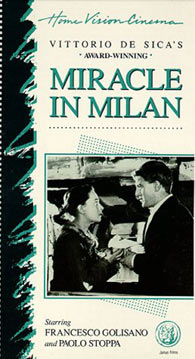

|
| home | movie reviews | features | sov horror | about | forum |
Miracle in Milan A
Year Released: 1951
Miracle in Milan is a delight. Unlike director Vittorio De Sica's masterpieces The Bicycle Thief and Umberto D, it is not an emotionally gripping film. Rather, it's a satire of an emotionally gripping film. Even during its darkest moments, a cheerful score accompanies the on-screen events and the mood never blackens. As an infant, Toto (Francesco Golisano) is found in a cabbage patch by an old woman who raises him until she dies. Toto is sent off to an orphanage and emerges from it looking for work. Unable to find any, he joins the army of the homeless and becomes their unspoken leader, spurred by his contagious optimism. They build huts in a vacant lot and develop unity. Even when town bigwig Mobbi (Guglielmo Barnabò) attempts to kick them off the shantytown properties, the smile never leaves Toto's face and he receives some magical aid to foil Mobbi's selfish schemes. Miracle in Milan represents the dreams of homeless people everywhere -- an angel swooping down and giving them the better life. De Sica treats it as such -- a dream. There's a wonderful scene in the first 30 minutes where the vagabonds stage a sunset at dusk, lining up chairs and collecting money from those who wish to view it. This is as close as we get to De Sica's usual neorealism. From then on, the film comfortably dissolves into fantasy. The final shot of the homeless flying away on broomsticks, quite daring for its time, is an image of the fantastical. Symbolism that would feel too obvious elsewhere seems natural here. A broken statue is discovered in a car trunk in the junkyard and two of the squatters fix it up and display it proudly at the central square. In Mobbi's office, where Toto leads a group to protest their eviction, a statue of Michelangelo's David stands behind Mobbi's desk. The contrast of sneering wealth versus timid poverty is quietly sarcastic, as is Miracle in Milan at its heart. Aldo Graziati's cinematography alternates between bleak and upbeat, capturing De Sica's visual style; a touch of depression, a large splash of hope. Emphasis is placed on faces; the camera focuses on the eyes of those who look beaten and those filled with hope. By the end of the film, it consists almost exclusively of the latter. We care deeply for Umberto in Umberto D because his plight feels so authentic. Miracle in Milan is a fairy tale -- it even begins, "Once upon a time." We rarely pity Toto despite his harsh situation. He won't let us pity him for he won't stop smiling. And we smile right along with him. Review published 07.11.2003.
|

|
| home | movie reviews | features | sov horror | about | forum |
| This site was previously at flipsidemovies.com from 2000 to 2008. |
|
contact | copyright | privacy | links | sitemap
Flipside Movie Emporium (FlipsideArchive.com)
|